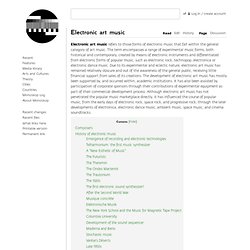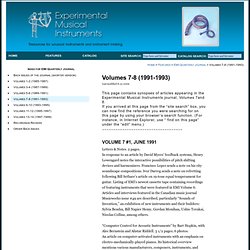

Chapter 4: Folk and Popular Culture - Chapter Notes Ch04.pdf. Electronic art music. Electronic art music refers to those forms of electronic music that fall within the general category of art music.

The term encompasses a range of experimental music forms, both historical and contemporary, created by means of electronic instruments and differentiated from electronic forms of popular music, such as electronic rock, technopop, electronica or electronic dance music. Due to its experimental and eclectic nature, electronic art music has remained relatively obscure and out of the awareness of the general public, receiving little financial support from sales of its creations. The development of electronic art music has mostly been supported by, and occurred within, academic institutions.
It has also been assisted by participation of corporate sponsors through their contributions of experimental equipment as part of their commercial development process. [edit] Composers He also understands this music to have a large impact on all contemporary composers: [edit] The Futurists. Sound art. Related terms: Klangkunst, sound installation (since late 1960s), Klanginstallation, sound-space-art (Leitner c1971 [1]), sound sculpture (see Grayson 1975), Klangskulptur, sound walk, sonic art (see Wishart 1985), musicalization of sound (see Lander 1990), sound in the arts (see Kahn 1999), audio art (see Föllmer 2004), Audiokunst, sound in art.

[edit] Pages The following is a growing list of artists, events and initiatives that have presented works of art with sound as their constituent means of expression. [edit] Compilations. Electronic and Experimental Music: Technology, Music, and Culture - Thom Holmes. Episode 15 The Prepared Mind: John Cage and David Tudor - Merce Cunningham Trust. DRAM: Notes for "David Tudor And Gordon Mumma" Had a teacher’s suggestion not backfired, one of the most extraordinary performers in twentieth-century music might have spent his musical life as a church organist.

Born in Philadelphia on January 20, 1926, David Tudor began piano lessons at the age of six. Five years later, and stimulated by the sound and mechanics of the small reed organ his father played at the family church, he auditioned for H. William Hawke, the organist and choirmaster at Philadelphia’s High Episcopal St. Mark’s Church. Digital Luthiere (Jordà, 2005) New Interfaces for Musical Expression. Leonardo Music Journal.
Volume 14, 2004 - Special: Composers Inside Electronic Music after David Tudor. Composers inside Electronics: Music after David Tudor. David Tudor: The Delicate Art of Falling. The Folk Music of Chance Electronics: Circuit-bending the Modern Coconut. A Musical Technography of John Bischoff. Zombie Media: Circuit Bending Media Archaeology into an Art Method. Defunct_refunct_catalogue_web.pdf. Computer Music Journal. Volume 32, Number 4, Winter 2008. Circuit-Bending: Build Your Own Alien Instruments. In lieu of an abstract, here is a brief excerpt of the content: Circuit-Bending: Build Your Own Alien Instruments is an insightful book on the subject of circuitbending, an art based on the modification of existing electronic circuits in order to unveil hidden features within them, specifically related to sonic output.

The writer, Qubais Reed Ghazala, is often referred to as the father of circuit-bending, since he accidentally pioneered this art in 1967, when a solid-state amplifier’s circuit was shorted due to contact with a metallic drawer. He witnessed the transformation of the amplifier into a synthesizer, emitting sound effects comparable to those produced by expensive commercial synthesizers. Thus, circuit-bending was born. The layout of the book is exceptional, starting from the cover, designed by Anthony Bunyan, depicting Mr.
The second part is more practical, describing the ideal workspace of a circuit-bender. Experimental Musical Instruments Volumes 7-8 (1991-1993) This page contains synopses of articles appearing in the Experimental Musical Instruments journal, Volumes 7and 8.

If you arrived at this page from the “site search” box, you can now find the reference you were searching for on this page by using your browser’s search function. (For instance, in Internet Explorer, use “ find on this page” under the “edit” menu.) Letters & Notes. 2 pages. In response to an article by David Myers’ feedback systems, Henry Lowengard notes the interactive possibilities of pitch shifting devices and harmonizers. Francisco Lopez sends a note on his city soundscape compositions. “Computer Control for Acoustic Instruments” by Bart Hopkin, with Alec Bernstein and Alistar Riddell. 3 1/2 pages; 6 photos. “The StarrBoard” by John Starrett. 3 pages; 4 photos, 1 diagram. “Driftwood Marimbas” by Bart Hopkin. 1 page; 2 photos. “Conjoined String Systems: Reports From Builders” by Mario Van Horrik and Paul Panhuysen. 3 1/2 pages; 3 photos, 4 drawings.
Letters. 3 pages. Audio Engineering Society (AES) CREATIVE ASPECTS OF LIVE-PERFORM MUSIC TECH. Handmade Sounds: Handmade Sounds:The Sonic Arts Union and American Technoculture.